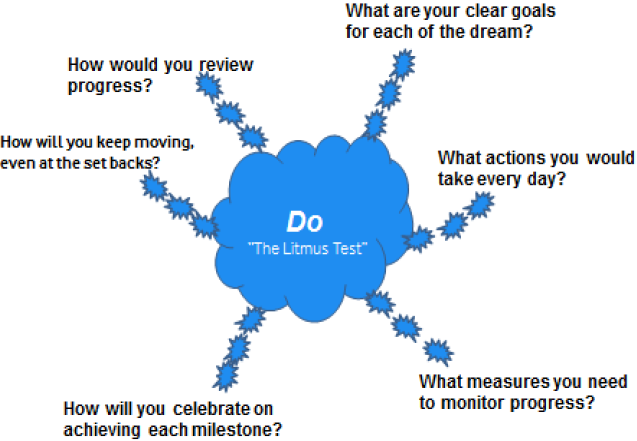Expected outcome:
At the end of this phase, the client would be in a position to see for himself the enormous opportunities that lay in front of him, would have heightened level of awareness of his own patterns of feeling and thinking. In the process of listing his future dreams, we could surface a few unfulfilled or aborted dreams also. Working on these might also provide valuable insights to the client’s overall disposition. With more careful deliberations, the client would be in a position to zero on the dreams he wants to work on. `
Design:
The Process:
Design, an important phase, which is also the mid-way of the coaching journey, gives the wings and limbs to the dreams to take off!!! Here, each of the dreams the client has chosen to pursue is analyzed. This analysis is bound to throw up the various possibilities of situations and responses that either support or restrain the client from achieving the dream. This is the space where the client’s dependency on the coach is bound to be high. The client may possibly even expect a solution and may be even ready to bequeath the “thinking “process to the coach!!! Dealing with certain underlying beliefs/ dysfunctional alignments/lack of confidence to stay focused are some of the challenges a coach may be required to deal during this phase. `
Expected outcome:
At the end of the design phase, the client may be in a position to “feel the dream “in terms of a destination or as a goal. By the quality of deliberations refined by some bold challenges of the client’s assumptions, use of rational tool such as brainstorming etc. and also due to the skill of the coach, the client would be in a position to have a clear visibility of the journey he sets himself towards realizing his dreams.
As a coach, being present, effective communication and powerful questioning are some of the competencies that would have come in play to help the client move from the State of dream to the start line of the journey. Effective use of re-framing perspectives, analogies, metaphors, role reversals, what if scenarios are the other possible tools a coach can use to bring about the clarity and confidence in the mind of the client to take the first step of the journey.
Do:
The Process:
The last phase of the journey, “The Action Phase” is the ultimate litmus test of the coaching journey. Having chosen a dream and converted that into a doable approach model, it is important to understand as to what constitutes action!!! Since the dreams are now represented by a goal or an end point, it should become much easier for the client to look ahead at the road with hope and optimism. Desires alone do not lead to destination. It needs a disturbance to the state of equilibrium and set the client in a motion. The client should be helped to figure out for himself the speed of the journey, the route to take, milestones for check back, fall back options and limits of tolerance and trade off. This is the key to the coaching process since the client is the prime mover and ownership for actions should rest on him squarely. This act of taking ownership, call upon the client to demonstrate his level of commitment, conviction to realize the dream and his focus towards the goals. `
An extensive research indicates that only 5 % of the behavior comes out of conscious state and 95% of our behaviors are unconscious (automatic). Also are evidences that suggest that almost 80% of the people, who attempt to change some things in their lives, slip back to their automated behavior within two months of the try.
Viewed from these facts, the client is the most vulnerable only during this point!! This is precisely when the coach can lend significant support to the client in the journey. Actions, albeit called behaviors are the real evidence to know that the client has begun his journey. With the knowledge that the journey may become difficult to start, sustain and complete, the coach should clearly veer the client to take ownership for taking the required actions.
Expected outcome:
Clearly agreeing to an action, creating evidence of an action being done, setting realistic measures to track progress, levels of celebration on aching each milestone, setting up an appropriate review of progress with the client, offering to help in any other way are some of the aspects a coach would need to look in to during this phase. The knowledge of the client’s strength/weakness obtained during the earlier two phases can be well harnessed by the coach in setting measures of progress.
Conclusion:
In real terms, a consummate coach can leave a sense with the client that may help him to conceive the journey as well as arriving at the destination as worthy learning that could accrue to him. .
The 3 D Coaching Model is designed with this outcome in mind and helps a client to meet his future from the present!!!

